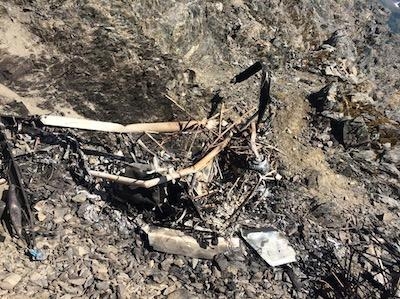Finds Pilot Had A High Concentration Of Alcohol In His System
The NTSB has released a factual report from an accident which occurred on August 4 in Girdwood, Alaska, which fatally injured the ATP-rated pilot and three passengers.

According to the report, the PA-22 150 was destroyed by impact and a postcrash fire when it collided with terrain about 5 miles north of Girdwood Airport (AQY), Girdwood, AK. The airplane was privately owned by one of the passengers and was being operated by the ATP pilot.
A friend of the airplane owner stated that he and the owner had been conversing via text message on the day of the accident. The owner, who held a student pilot certificate, indicated that he and the pilot had been drinking alcoholic beverages, but stated that he would not be flying the airplane and would be a passenger on the accident flight. The purpose of the flight was to take the passengers on a short 15-20-minute sightseeing flight of the Girdwood area, which consists of remote, steep, mountainous terrain, ranging from sea level to about 7,000 ft, which is part of the Chugach Mountain Range.
Multiple witnesses observed the airplane flying parallel to a mountain ridge before it entered a turn to the north and began a descent. The airplane then disappeared from view, and then they saw a plume of black smoke. One witness saw the airplane performing aggressive maneuvers earlier in the flight, and observed the airplane approach a mountain ridge, its nose pitched up and the airplane entered a steep climb before disappearing from view. No witnesses reported hearing any unusual sounds from the accident airplane.
An autopsy of the pilot was performed by the Alaska State Medical Examiner, Anchorage, Alaska. The cause of death was attributed to multiple blunt (deceleration type) injuries.
Postmortem toxicological testing by the Alaska State Medical Examiner of the pilot's femoral blood was positive for ethanol at 0.226 grams per deciliter (gm/dl). Toxicology testing performed at the FAA Forensic Sciences Laboratory detected ethanol in cavity blood at 0.252 gm/dl and in vitreous fluid at 0.238 gm/dl; methanol in an amount too low to quantify was detected in cavity blood and vitreous fluid.
Toxicology testing of the student pilot/passenger performed at the FAA Forensic Sciences Laboratory detected ethanol in vitreous fluid at 0.058 gm/dl and in brain and muscle at 0.055 and 0.038 grams per hectogram, respectively.
The remote accident site was located on the south face of Goat Mountain in steep, mountainous terrain. The airplane impacted the terrain about 15 ft below the top of a rock-faced ridgeline at an altitude of about 5,512 ft mean sea level (msl) and came to rest inverted on a narrow rock shelf at an altitude of about 5,437 ft msl. The wreckage was largely consumed by postcrash fire; small fragments of wreckage were located on the opposite side of the ridge.
The airplane was not recovered and could not be examined. Review of photographs provided by the Alaska Mountain Rescue Group and the Alaska State Troopers revealed that the left and right wings and their respective control surfaces were destroyed by fire, with only portions of the wing spars remaining. The cockpit, fuselage, and empennage exhibited extensive thermal damage and control continuity could not be verified.
The engine exhibited extensive impact and thermal damage. The propeller separated from the engine crankshaft. One propeller blade exhibited torsional "S" twisting and aft bending about 12 inches from the tip. The other propeller blade exhibited significant torsional "S" twisting and buckling on the trailing edge of the blade.
(Image provided with NTSB Accident docket)
 ANN's Daily Aero-Term (04.26.24): DETRESFA (Distress Phrase)
ANN's Daily Aero-Term (04.26.24): DETRESFA (Distress Phrase) Aero-News: Quote of the Day (04.26.24)
Aero-News: Quote of the Day (04.26.24) ANN's Daily Aero-Term (04.27.24): Direct
ANN's Daily Aero-Term (04.27.24): Direct ANN's Daily Aero-Linx (04.27.24)
ANN's Daily Aero-Linx (04.27.24) Aero-News: Quote of the Day (04.27.24)
Aero-News: Quote of the Day (04.27.24)



